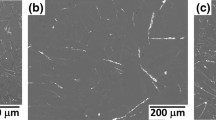Abstract
Effect of alloying elements on fracture behavior of Fe-18Ni-2Ti-(8Co) alloys has been investigated in the light of grain boundary segregation of alloying elements. During isothermal aging at 540°C, hardness level in the cobalt-bearing alloy was higher than that in the cobalt-free alloy, which is attributed to the solid solution hardening of cobalt, and the bigger hardness difference after overaging was due to the relatively fine precipitates in the cobalt-bearing alloy. The grain boundary segregation behavior of the elements was similar in two alloys, regardless of the cobalt addition. In two alloys, the fracture behavior before and after the maximum tensile strength is mainly governed by two factors: titanium at the grain boundaries and over-aging. Up to the aging time corresponding to the maximum tensile strength, the intergranular fracture strength was roughly inversely proportional to the titanium level at the grain boundaries, and after the time the tensile strength decreased with restoring ductility. Nickel or cobalt was not effective on the grain boundary strengthening of the iron-based alloys.
Similar content being viewed by others
References
J. R. Mihalisin,Trans. Quart. ASM 59, 60 (1966).
M. Tanaka, T. Suzukiadn J. Komura,J. Japan Inst. Metals 32, 1016 (1967).
S. Floreen and G. R. Speich,Trans. ASM. 57, 714 (1964).
G. P. Miller and W. I. Mitchell,J. Iron Steel Inst. 203, 899 (1965).
M. P. Seah,Surf. Sci. 53, 168 (1975).
E. D. Hondros, M. P. Seah and C. Lea,Metals and Materials January, 26 (1976).
M. P. Seah,Proc. R. Soc. London(A) 349, 535 (1976).
C. J. McMahon Jr and L. Marcut,J. Vac. Sci. Technol. 15, 450 (1978).
W. Steven and J. Balajiva,J. Iron and Steel Inst. 193, 141 (1959).
B. J. Schulz and C. J. McMahon,ASTM-STP, ASTM, Philadelphia, PA,499, 104 (1972).
Y. Q. Weng and C. J. McMahon,Mater. Sci. Technol. 3, 207 (1986).
R. K. Pitler and G. S. Ansell,Quart. ASM,57, 220 (1964).
R. D. Garwood and R. D. Jones,J. Iron Steel Inst. 204, 512 (1966).
G. R. Speich,Trans. Met. Soc. A. I. M. E. 227, 1426 (1963).
N. H. Heo:Acta Metall. 44, 3015 (1996).
N. H. Heo:Metall. Trans. 27A, 3059 (1996).
N. H. Heo and C. H. Lee:Metall. Trans. 27A, 1015 (1996).
N. H. Heo:Acta Metall. 44, 1581 (1996).
N. H. Heo:Materials Trans. JIM 33, 56 (1996).
M. P. Seah,Acta Metall. 28, 955 (1980).
Author information
Authors and Affiliations
Rights and permissions
About this article
Cite this article
Heo, N.H., Na, J.G. Effect of alloying elements on fracture behavior of Fe-18Ni-2Ti-(8Co) alloys. Metals and Materials 3, 125–129 (1997). https://doi.org/10.1007/BF03026136
Issue Date:
DOI: https://doi.org/10.1007/BF03026136




